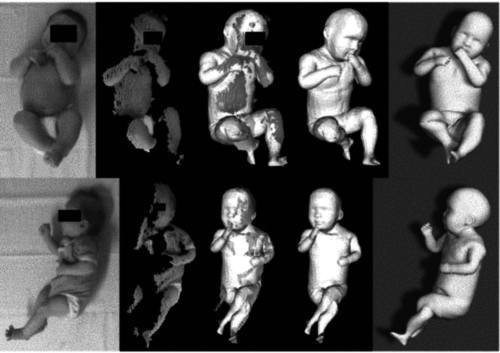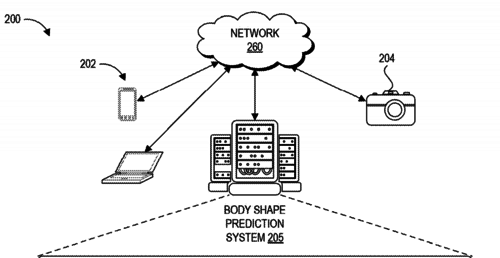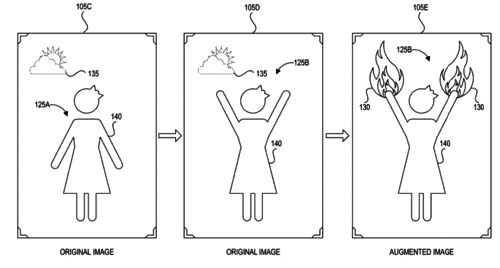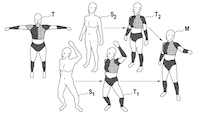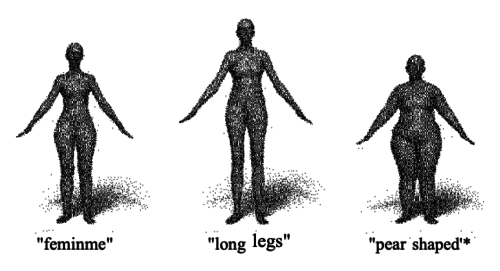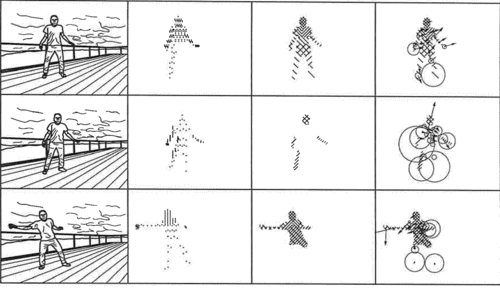8 results
(View BibTeX file of all listed publications)
2021
Skinned multi-infant linear body model
Hesse, N., Pujades, S., Romero, J., Black, M.
(US Patent 11,127,163, 2021), September 2021 (patent)
A computer-implemented method for automatically obtaining pose and shape parameters of a human body. The method includes obtaining a sequence of digital 3D images of the body, recorded by at least one depth camera; automatically obtaining pose and shape parameters of the body, based on images of the sequence and a statistical body model; and outputting the pose and shape parameters. The body may be an infant body.
2020
Machine learning systems and methods of estimating body shape from images
Black, M., Rachlin, E., Heron, N., Loper, M., Weiss, A., Hu, K., Hinkle, T., Kristiansen, M.
(US Patent 10,679,046), June 2020 (patent)
Disclosed is a method including receiving an input image including a human, predicting, based on a convolutional neural network that is trained using examples consisting of pairs of sensor data, a corresponding body shape of the human and utilizing the corresponding body shape predicted from the convolutional neural network as input to another convolutional neural network to predict additional body shape metrics.
Machine learning systems and methods for augmenting images
Black, M., Rachlin, E., Lee, E., Heron, N., Loper, M., Weiss, A., Smith, D.
(US Patent 10,529,137 B1), January 2020 (patent)
Disclosed is a method including receiving visual input comprising a human within a scene, detecting a pose associated with the human using a trained machine learning model that detects human poses to yield a first output, estimating a shape (and optionally a motion) associated with the human using a trained machine learning model associated that detects shape (and optionally motion) to yield a second output, recognizing the scene associated with the visual input using a trained convolutional neural network which determines information about the human and other objects in the scene to yield a third output, and augmenting reality within the scene by leveraging one or more of the first output, the second output, and the third output to place 2D and/or 3D graphics in the scene.
2019
Method for providing a three dimensional body model
Loper, M., Mahmood, N., Black, M.
September 2019, U.S.~Patent 10,417,818 (patent)
A method for providing a three-dimensional body model which may be applied for an animation, based on a moving body, wherein the method comprises providing a parametric three-dimensional body model, which allows shape and pose variations; applying a standard set of body markers; optimizing the set of body markers by generating an additional set of body markers and applying the same for providing 3D coordinate marker signals for capturing shape and pose of the body and dynamics of soft tissue; and automatically providing an animation by processing the 3D coordinate marker signals in order to provide a personalized three-dimensional body model, based on estimated shape and an estimated pose of the body by means of predicted marker locations.
2018
Co-Registration – Simultaneous Alignment and Modeling of Articulated 3D Shapes
Black, M., Hirshberg, D., Loper, M., Rachlin, E., Weiss, A.
February 2018, U.S.~Patent 9,898,848 (patent)
Present application refers to a method, a model generation unit and a computer program (product) for generating trained models (M) of moving persons, based on physically measured person scan data (S). The approach is based on a common template (T) for the respective person and on the measured person scan data (S) in different shapes and different poses. Scan data are measured with a 3D laser scanner. A generic personal model is used for co-registering a set of person scan data (S) aligning the template (T) to the set of person scans (S) while simultaneously training the generic personal model to become a trained person model (M) by constraining the generic person model to be scan-specific, person-specific and pose-specific and providing the trained model (M), based on the co registering of the measured object scan data (S).
2017
Crowdshaping Realistic 3D Avatars with Words
Streuber, S., Ramirez, M. Q., Black, M., Zuffi, S., O’Toole, A., Hill, M. Q., Hahn, C. A.
August 2017, Application PCT/EP2017/051954 (patent)
2016
Skinned multi-person linear model
Black, M., Loper, M., Mahmood, N., Pons-Moll, G., Romero, J.
December 2016, Application PCT/EP2016/064610 (patent)
The invention comprises a learned model of human body shape and pose dependent shape variation that is more accurate than previous models and is compatible with existing graphics pipelines. Our Skinned Multi-Person Linear model (SMPL) is a skinned vertex based model that accurately represents a wide variety of body shapes in natural human poses. The parameters of the model are learned from data including the rest pose template, blend weights, pose-dependent blend shapes, identity- dependent blend shapes, and a regressor from vertices to joint locations. Unlike previous models, the pose-dependent blend shapes are a linear function of the elements of the pose rotation matrices. This simple formulation enables training the entire model from a relatively large number of aligned 3D meshes of different people in different poses. The invention quantitatively evaluates variants of SMPL using linear or dual- quaternion blend skinning and show that both are more accurate than a Blend SCAPE model trained on the same data. In a further embodiment, the invention realistically models dynamic soft-tissue deformations. Because it is based on blend skinning, SMPL is compatible with existing rendering engines and we make it available for research purposes.
2013
Human Pose Calculation from Optical Flow Data
European Patent Application EP 2843621 , August 2013 (patent)

